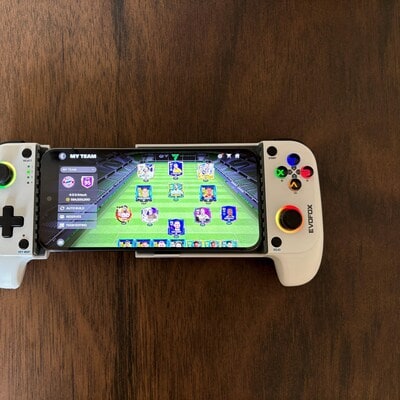Home-grown consumer electronics brand Amkette recently introduced the EvoFox Deck, a handheld gamepad for Android and iOS smartphones aimed at delivering a console-like gaming experience. With multi-platform support and various customisation options, such as key mapping for games without native controller compatibility, the EvoFox Deck offers features typically found in higher-priced alternatives. But does this smartphone controller truly provide a natural gamepad experience? And how well has the company optimised it for cross-platform functionality? Let us find out.
Design
Click here to connect with us on WhatsApp
The EvoFox Deck adopts a setup similar to the Xbox controller, featuring diagonally positioned analogue sticks—one on each side. The D-pad is located on the left, while the action buttons are on the right, with shoulder buttons and triggers positioned at the top on both sides. Additionally, the controller includes customisable RGB lighting around the analogue sticks and beneath the action buttons, which can also be turned off completely. This layout will feel familiar to Xbox or PC players, although PlayStation users might need some time to adjust.
The controller is entirely made of plastic but feels solid and durable. It strikes a good balance in terms of weight—light enough for comfortable use yet substantial enough to avoid feeling flimsy. The front and back panels have a matte finish, while the handles feature a web-like texture, enhancing grip. Silicon grippers are integrated into the casing, ensuring a secure hold on your smartphone. This is complemented by a well-tuned spring mechanism that holds the phone in place without exerting excessive pressure.
While the D-pad and action buttons are well-positioned, the placement of the right analogue stick feels somewhat awkward due to the vertical design of the handles. This occasionally makes the bottom-right analogue stick feel too close to the palm during gameplay.
Compatibility and companion apps
The EvoFox Deck is compatible with Android, iOS, and PC, though it is primarily designed for smartphone gaming. It mimics the DualShock 4 controller when pairing with iPhones and iPads and appears as a “Wireless Controller” on Android. Despite these differences, the pairing process is quick and straightforward for both platforms.
It is important to note that not all smartphone games support controllers natively. However, for those that do, the EvoFox Deck offers a plug-and-play experience. On Android, the controller features a Key Map mode, allowing you to map keys for games that lack native controller support. Unfortunately, this feature is not available on iOS, limiting its usability with iPhones. That said, I tested the controller with several AAA titles ported to iPhones, such as Assassin’s Creed Mirage and Resident Evil 7 Biohazard, and most supported gamepad control.
The main companion app for the EvoFox Deck is the Dojo app, available for both Android and iOS. The app functions as a gaming hub, providing access to all your games from a single interface. It also recommends games with native controller support and directs you to the Play Store on Android. The iOS version works similarly but is less smooth, and the app does not always redirect you to the App Store as expected. Additionally, in-app access to cloud gaming services like Xbox, Steam Link, and PS Remote Play is limited to the Android version.
For key mapping on Android, the controller uses a third-party app called ShootingPlus V3. This app provides pre-set layouts for most games available on the Play Store and allows for layout customisation and key assignment. However, remapping the shoulder buttons and triggers is not always an option, which can be limiting.
Experience
I tested the EvoFox Deck on both Android and iOS, and it delivered an impressive gaming experience. If you are accustomed to playing with gamepads, using the Deck for smartphone gaming feels quite natural. Whether it is a racing game like Real Racing 3, which demands precise analogue stick control, or action games like Injustice that require simultaneous key presses and movements, the EvoFox Deck performs consistently well. I also tried FC Mobile, and it almost felt like playing an FC series game on the Nintendo Switch.
After a month of use, I encountered no dead key issues or analogue stick drifting. The action buttons provide the right amount of pressure response, while the shoulder and trigger buttons offer a satisfying click. However, the D-pad is less accurate and responsive. When playing retro games on emulators, I noticed that diagonal inputs on the D-pad often resulted in unintended upward or sideways movement. Although switching to the analogue sticks provides better precision, many emulators still lack support for analogue controls.
I also observed that my smartphone occasionally overheated while playing games with mapped keys, likely due to the ShootingPlus V3 app running alongside the game with an overlay. This overheating sped up battery drain, and unfortunately, you cannot charge your phone while it is placed in the Deck.
As for the EvoFox Deck’s battery life, it easily lasts up to six hours of gameplay, though this depends on usage and the types of games played. I also found that turning off the RGB lights extended the battery life.
Verdict
Priced at Rs 2,999, the EvoFox Deck is an excellent choice for those seeking a smartphone gamepad on budget. It features a solid build, comfortable grip, and delivers a familiar and natural gaming experience while being compatible across multiple platforms. However, the controller is especially well-suited for Android due to the superior companion app and the ability to map keys for games that lack native controller support.
That said, the companion app for both Android and iOS could use some improvements. It would be beneficial to have more controller customisation options within the app, as well as a built-in key mapping feature. Despite these minor drawbacks, the EvoFox Deck offers outstanding value for money.
First Published: Oct 14 2024 | 3:05 PM IST
